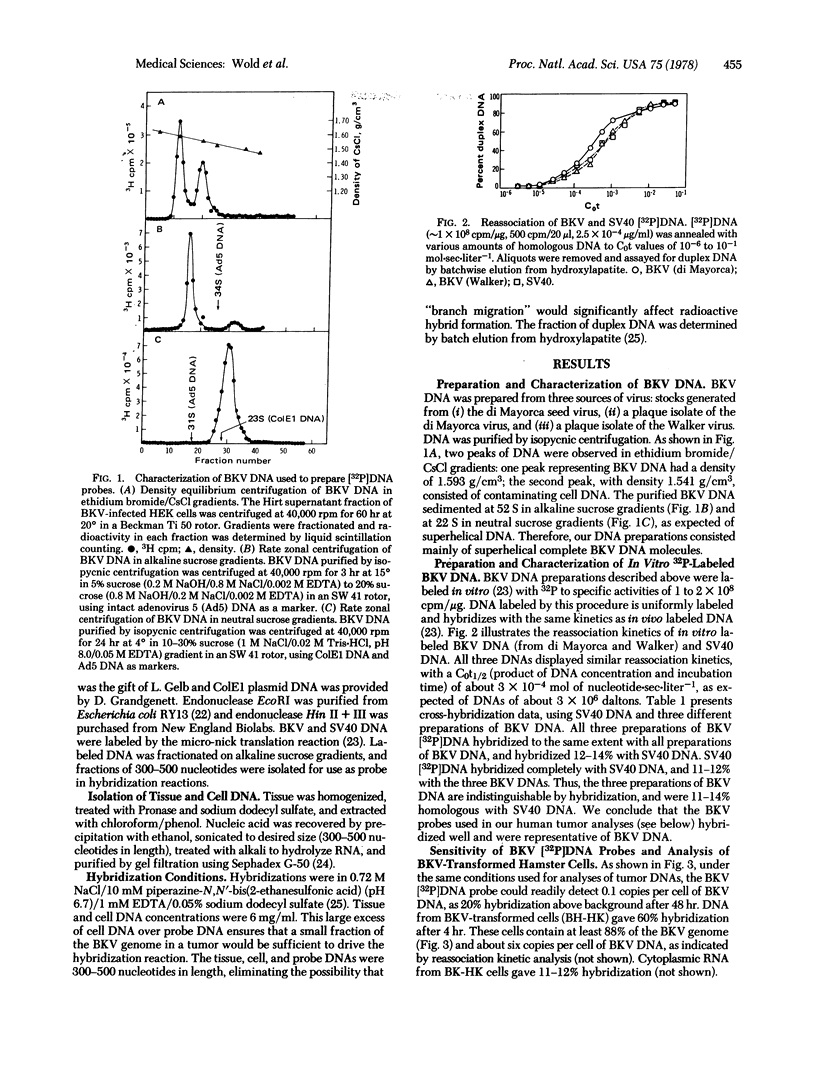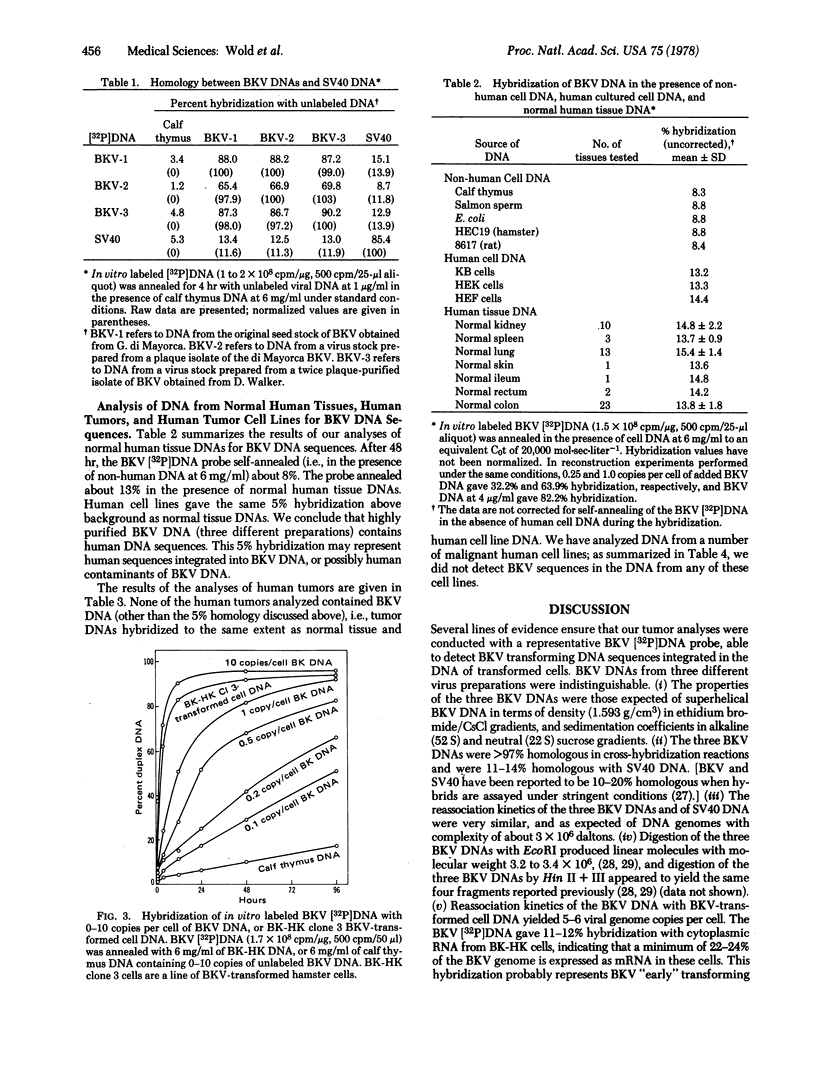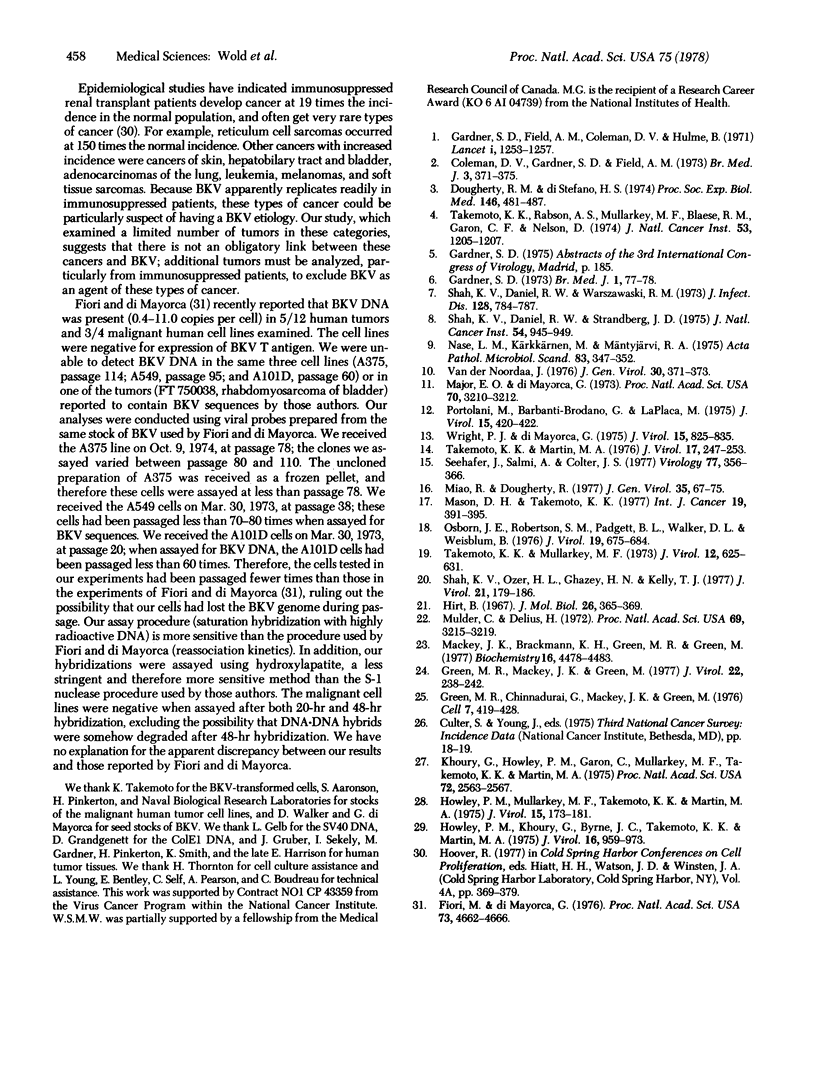Abstract
Most humans in the United States have been infected with BK virus (BKV), a human papovavirus. Because BKV has oncogenic properties, we have investigated whether it may be a cause of human cancer. Basic principles of tumor virology imply that BKV-induced tumors should contain BKV DNA sequences. Therefore, we assayed (by molecular hybridization) DNA from human tumors and malignant cell lines for BKV DNA, using BKV [32P]DNA as probe. The BKV [32P]DNA was labeled in vitro (nick translation) to specific activities of 1 to 2 × 108 cpm/μg. The BKV DNA used to prepare our probes had the properties expected of authentic BKV genomes, including density of superhelical DNA, sedimentation velocity in alkaline and neutral sucrose gradients, production of one fragment by endonuclease EcoRI cleavage and four fragments by endonuclease Hin II + III cleavage and reassociation properties. From these studies we conclude that our BKV probes hybridized well, and represented bona fide BKV DNA. Using three different BKV [32P]DNA probes, i.e., from three distinct plaque isolates, we have analyzed DNA from BKV-transformed cells, normal human tissues, and a large number of human tumors. All human DNAs (cell lines, normal tissues, tumors) hybridized 5% with BKV DNA. Hybridization analysis of BKV-transformed hamster cell DNA indicated 5-6 copies of at least 88% of the BKV genome per cell. No BKV DNA sequences were detected (above the normal 5% hybridization to all human DNAs) in the following normal human tissues: 10 kidney (BKV is usually isolated from urine), 3 spleen, 13 lung, 23 colon, 2 rectum, 1 ileum, and 1 skin. No BKV-specific DNA was found in 166 tumors, including 5 carcinomas (Ca) of stomach, 3 Ca small intestine, 26 Ca colon, 9 Ca rectum, 31 Ca lung, 9 adenocarcinomas and 5 oat cell carcinomas of lung, 17 melanomas, 5 Ca prostate, 4 Ca bladder, 6 Wilms tumors, 4 hypernephromas, 15 Ca kidney, 7 brain tumors, 5 Hodgkin lymphomas, 10 lymphomas (immunosuppressed patients have a high incidence of lymphomas), 2 reticulum cell sarcomas (spleen), and 3 skin tumors. We have also analyzed 7 human malignant cell lines (melanoma, lung, rhabdomyosarcoma, and glioblastomas), including several clones of a lung melanoma line; no BKV DNA sequences were detected. Because our probes could detect one copy of BKV DNA if only 10% of the cells were tumor cells, our results are very strong evidence that the tumors we analyzed did not have a BKV etiology. The tumors we tested represent about 50% of all cancers in the United States; there is no evidence that BKV is involved in the etiology of these types of tumors.
Keywords: molecular hybridization, BK virus-transformed hamster cells, human cancer
Full text
PDF




Selected References
These references are in PubMed. This may not be the complete list of references from this article.
- Coleman D. V., Gardner S. D., Field A. M. Human polyomavirus infection in renal allograft recipients. Br Med J. 1973 Aug 18;3(5876):371–375. doi: 10.1136/bmj.3.5876.371. [DOI] [PMC free article] [PubMed] [Google Scholar]
- Dougherty R. M., DiStefano H. S. Isolation and characterization of a papovavirus from human urine. Proc Soc Exp Biol Med. 1974 Jun;146(2):481–487. doi: 10.3181/00379727-146-38131. [DOI] [PubMed] [Google Scholar]
- Fiori M., Di Mayorca G. Occurrence of BK virus DNA in DNA obtained from certain human tumors. Proc Natl Acad Sci U S A. 1976 Dec;73(12):4662–4666. doi: 10.1073/pnas.73.12.4662. [DOI] [PMC free article] [PubMed] [Google Scholar]
- Gardner S. D., Field A. M., Coleman D. V., Hulme B. New human papovavirus (B.K.) isolated from urine after renal transplantation. Lancet. 1971 Jun 19;1(7712):1253–1257. doi: 10.1016/s0140-6736(71)91776-4. [DOI] [PubMed] [Google Scholar]
- Gardner S. D. Prevalence in England of antibody to human polyomavirus (B.k.). Br Med J. 1973 Jan 13;1(5845):77–78. doi: 10.1136/bmj.1.5845.77. [DOI] [PMC free article] [PubMed] [Google Scholar]
- Green M. R., Chinnadurai G., Mackey J. K., Green M. A unique pattern of integrated viral genes in hamster cells transformed by highly oncogenic human adenovirus 12. Cell. 1976 Mar;7(3):419–428. doi: 10.1016/0092-8674(76)90172-0. [DOI] [PubMed] [Google Scholar]
- Green M. R., Mackey J. K., Green M. Multiple copies of human adenovirus 12 genomes are integrated in virus-induced hamster tumors. J Virol. 1977 Apr;22(1):238–242. doi: 10.1128/jvi.22.1.238-242.1977. [DOI] [PMC free article] [PubMed] [Google Scholar]
- Hirt B. Selective extraction of polyoma DNA from infected mouse cell cultures. J Mol Biol. 1967 Jun 14;26(2):365–369. doi: 10.1016/0022-2836(67)90307-5. [DOI] [PubMed] [Google Scholar]
- Howley P. M., Khoury G., Byrne J. C., Takemoto K. K., Martin M. A. Physical map of the BK virus genome. J Virol. 1975 Oct;16(4):959–973. doi: 10.1128/jvi.16.4.959-973.1975. [DOI] [PMC free article] [PubMed] [Google Scholar]
- Howley P. M., Mullarkey M. F., Takemoto K. K., Martin M. A. Characterization of human papovavirus BK DNA. J Virol. 1975 Jan;15(1):173–181. doi: 10.1128/jvi.15.1.173-181.1975. [DOI] [PMC free article] [PubMed] [Google Scholar]
- Khoury G., Howley P. M., Garon C., Mullarkey M. F., Takemoto K. K., Martin M. A. Homology and relationship between the genomes of papovaviruses, BK virus and simian virus 40. Proc Natl Acad Sci U S A. 1975 Jul;72(7):2563–2567. doi: 10.1073/pnas.72.7.2563. [DOI] [PMC free article] [PubMed] [Google Scholar]
- Mackey J. K., Brackmann K. H., Green M. R., Green M. Preparation and characterization of highly radioactive in vitro labeled adenovirus DNA and DNA restriction fragments. Biochemistry. 1977 Oct 4;16(20):4478–4483. doi: 10.1021/bi00639a023. [DOI] [PubMed] [Google Scholar]
- Major E. O., Di Mayorca G. Malignant transformation of BHK21 clone 13 cells by BK virus--a human papovavirus. Proc Natl Acad Sci U S A. 1973 Nov;70(11):3210–3212. doi: 10.1073/pnas.70.11.3210. [DOI] [PMC free article] [PubMed] [Google Scholar]
- Mason D. H., Jr, Takemoto K. K. Transformation of rabbit kidney cells by BKV(MM) human papovavirus. Int J Cancer. 1977 Mar 15;19(3):391–395. doi: 10.1002/ijc.2910190317. [DOI] [PubMed] [Google Scholar]
- Miao R., Dougherty R. M. Characterization of human papovavirus RFV: comparison with SV40 and BKV. J Gen Virol. 1977 Apr;35(1):67–75. doi: 10.1099/0022-1317-35-1-67. [DOI] [PubMed] [Google Scholar]
- Mulder C., Delius H. Specificity of the break produced by restricting endonuclease R 1 in Simian virus 40 DNA, as revealed by partial denaturation mapping. Proc Natl Acad Sci U S A. 1972 Nov;69(11):3215–3219. doi: 10.1073/pnas.69.11.3215. [DOI] [PMC free article] [PubMed] [Google Scholar]
- Näse L. M., Kärkkäinen M., Mäntyjärvi R. A. Transplantable hamster tumors induced with the BK virus. Acta Pathol Microbiol Scand B. 1975 Aug;83(4):347–352. doi: 10.1111/j.1699-0463.1975.tb00112.x. [DOI] [PubMed] [Google Scholar]
- Osborn J. E., Robertson S. M., Padgett B. L., Walker D. L., Weisblum B. Comparison of JC and BK human papovaviruses with simian virus 40: DNA homology studies. J Virol. 1976 Aug;19(2):675–684. doi: 10.1128/jvi.19.2.675-684.1976. [DOI] [PMC free article] [PubMed] [Google Scholar]
- Portolani M., Barbanti-Brodano G., Placa M. L. Malignant transformation of hamster kidney cells by BK virus. J Virol. 1975 Feb;15(2):420–422. doi: 10.1128/jvi.15.2.420-422.1975. [DOI] [PMC free article] [PubMed] [Google Scholar]
- Seehafer J., Salmi A., Colter J. S. Isolation and characterization of BK virus-transformed hamster cells. Virology. 1977 Mar;77(1):356–366. doi: 10.1016/0042-6822(77)90432-9. [DOI] [PubMed] [Google Scholar]
- Shah K. V., Daniel R. W., Strandberg J. D. Sarcoma in a hamster inoculated with BK virus, a human papovavirus. J Natl Cancer Inst. 1975 Apr;54(4):945–950. [PubMed] [Google Scholar]
- Shah K. V., Daniel R. W., Warszawski R. M. High prevalence of antibodies to BK virus, an SV40-related papovavirus, in residents of Maryland. J Infect Dis. 1973 Dec;128(6):784–787. doi: 10.1093/infdis/128.6.784. [DOI] [PubMed] [Google Scholar]
- Shah K. V., Ozer H. L., Ghazey H. N., Kelly T. J., Jr Common structural antigen of papovaviruses of the simian virus 40-polyoma subgroup. J Virol. 1977 Jan;21(1):179–186. doi: 10.1128/jvi.21.1.179-186.1977. [DOI] [PMC free article] [PubMed] [Google Scholar]
- Takemoto K. K., Martin M. A. Transformation of hamster kidney cells by BK papovavirus DNA. J Virol. 1975 Jan;17(1):247–253. doi: 10.1128/jvi.17.1.247-253.1976. [DOI] [PMC free article] [PubMed] [Google Scholar]
- Takemoto K. K., Mullarkey M. F. Human papovavirus, BK strain: biological studies including antigenic relationship to simian virus 40. J Virol. 1973 Sep;12(3):625–631. doi: 10.1128/jvi.12.3.625-631.1973. [DOI] [PMC free article] [PubMed] [Google Scholar]
- Takemoto K. K., Rabson A. S., Mullarkey M. F., Blaese R. M., Garon C. F., Nelson D. Isolation of papovavirus from brain tumor and urine of a patient with Wiskott-Aldrich syndrome. J Natl Cancer Inst. 1974 Nov;53(5):1205–1207. doi: 10.1093/jnci/53.5.1205. [DOI] [PubMed] [Google Scholar]
- Wright P. J., Di Mayorca G. Virion polypeptide composition of the human papovavirus BK: comparison with simian virus 40 and polyoma virus. J Virol. 1975 Apr;15(4):828–835. doi: 10.1128/jvi.15.4.828-835.1975. [DOI] [PMC free article] [PubMed] [Google Scholar]
- van der Noordaa J. Infectivity, oncogenicity and transforming ability of BK virus and BK virus DNA. J Gen Virol. 1976 Mar;30(3):371–373. doi: 10.1099/0022-1317-30-3-371. [DOI] [PubMed] [Google Scholar]


